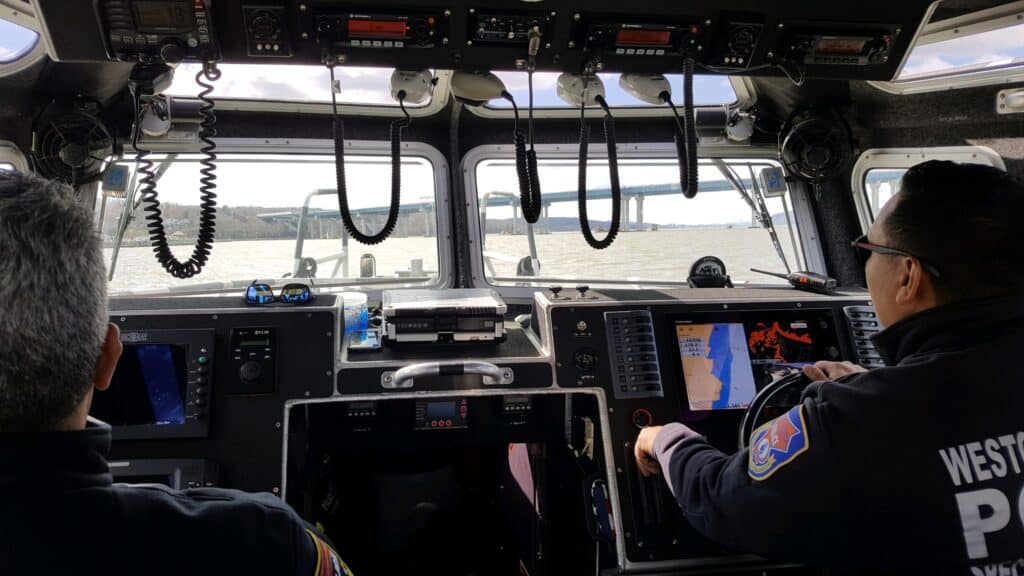
The Westchester County Police Marine Unit will have an increased presence on the Hudson River and Long Island Sound through the July 4 holiday to ensure boater safety and to participate in a nationwide Boating While Intoxicated enforcement campaign.
In addition to the maritime enforcement, County Police will conduct roving DWI patrols on Westchester parkways and will deploy additional officers to County parks, including at Kensico Dam Plaza on July 3 for Westchester’s annual fireworks display.
Public Safety Commissioner Terrance Raynor said there is always an increase in recreational boating traffic around the July 4 holiday period. He urged all recreational boaters to review safety protocols, ensure their vessels are seaworthy and check that all legally required safety equipment is on board, including Personal Flotation Devices (PFDs).
Raynor noted that the Marine Unit is participating this weekend in Operation Dry Water, a national enforcement effort aimed at combatting Boating While Intoxicated. Alcohol use is the leading contributing factor in recreational boating-related deaths and accidents, according to federal statistics.
“It is a crime to operate a boat or personal watercraft while under the influence of alcohol or drugs, just as it is for operating a motor vehicle. We have zero tolerance for BWI on Westchester waterways,” he said.
The Marine Unit will also be assisting at several municipal fireworks displays in waterfront communities on the Hudson and the Long Island Sound. Marine Unit patrol boats will be deployed to create a safety and security zone around barges that will be used during these fireworks events.
The Marine Unit offers the following tips to help ensure a safe and pleasant boating season on the Hudson River and Long Island Sound.
Before heading out on the water:
- Take a boating safety course. Boater inexperience is responsible for a large number of accidents and emergencies on the water each summer. By taking a safety course, you will ensure that you are familiar with navigation laws and boating etiquette and will learn what to do in the event of a mechanical failure, accident or other emergency. All persons born on or after Jan. 1, 1993, are required to have a boating safety certificate to operate a vessel or PWC.
- Make sure the boat you are using is safe. The Westchester County Police Marine Unit and the U.S. Coast Guard Auxiliary offer free vessel inspections to help boat owners meet this goal.
- Be sure the boat has the legally required safety equipment aboard. The required items include: Personal Flotation Devices (one for every person on board), a Type IV throw-able flotation device; visual and audible distress devices, fire extinguishers, an anchor and navigation and anchor lights. Though not legally required, a marine radio and/or a waterproof cellular telephone are recommended as the easiest ways to call for help in an emergency on the water.
- Have a float plan and leave it with someone on shore. Be sure that the plan indicates what time you will be leaving, where you will be going and what time you estimate you will return.
- Check local weather forecasts for marine-related information prior to your departure.
Once on the water:
- Children under the age of 12 must wear a Personal Flotation Device (PFD) at all times when aboard a boat of less than 65 feet in length (unless within a fully enclosed cabin of the vessel).
- Everyone aboard a Personal Watercraft must wear a PFD in New York State.
- A PFD must be available for every person on board (including in kayaks, canoes and rowboats) and is recommended to be worn on the water by persons of every age. It is estimated that 70 percent of all boating-related deaths could be prevented if PFDs were more fully utilized.
- In New York, any pleasure vessel, whether propelled in whole or part by mechanical means, must be registered with the Department of Motor Vehicles. The operator of the vessel, whether the owner or not, is required to be in possession of the original registration when the vessel is in operation.
- Navigation law requires all vessels to operate at 5 mph or less within 100 yards of the shoreline or any anchored vessel.





